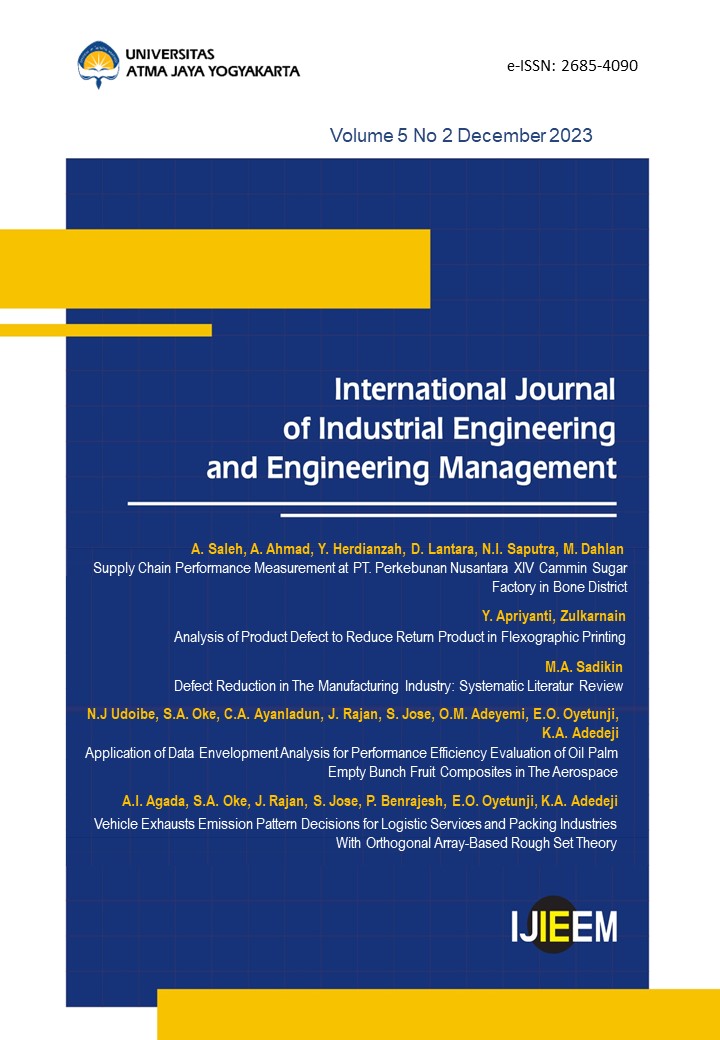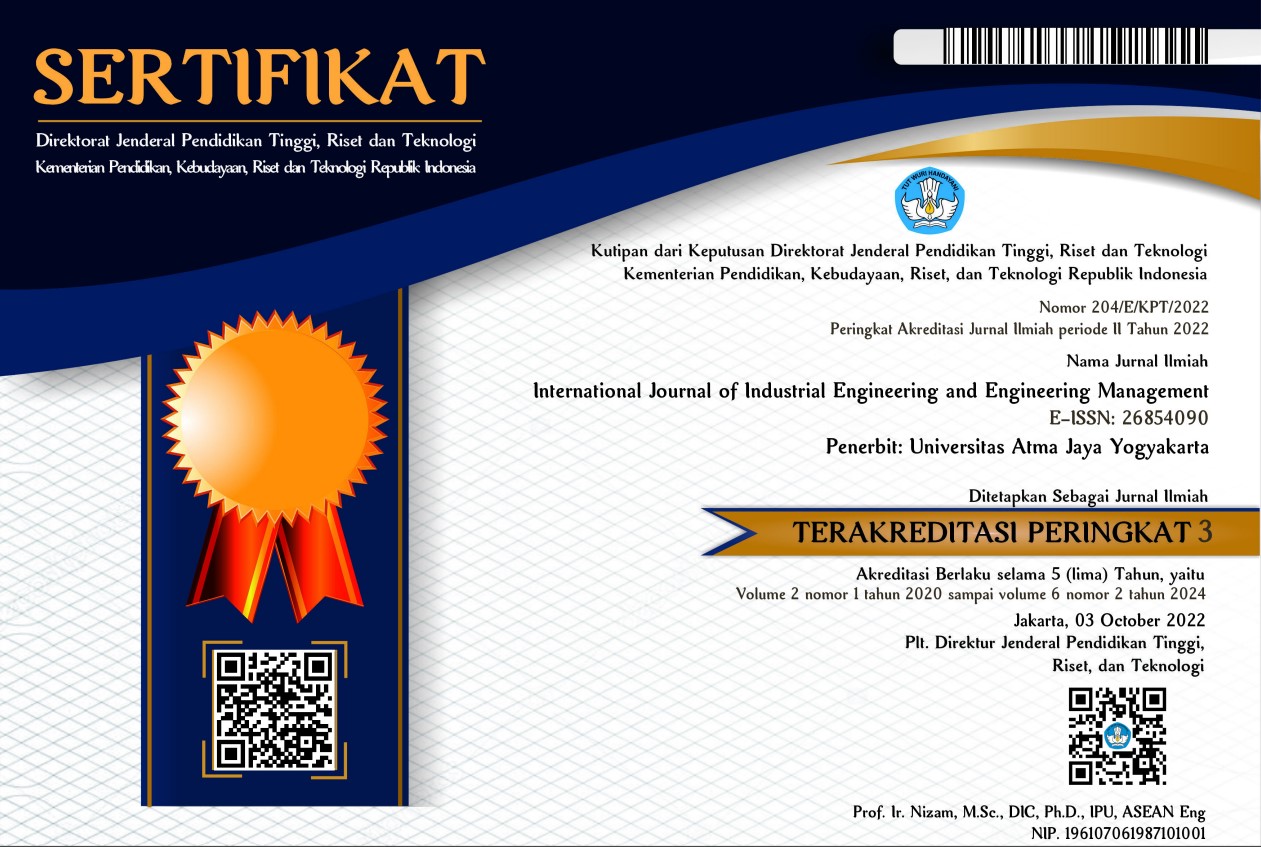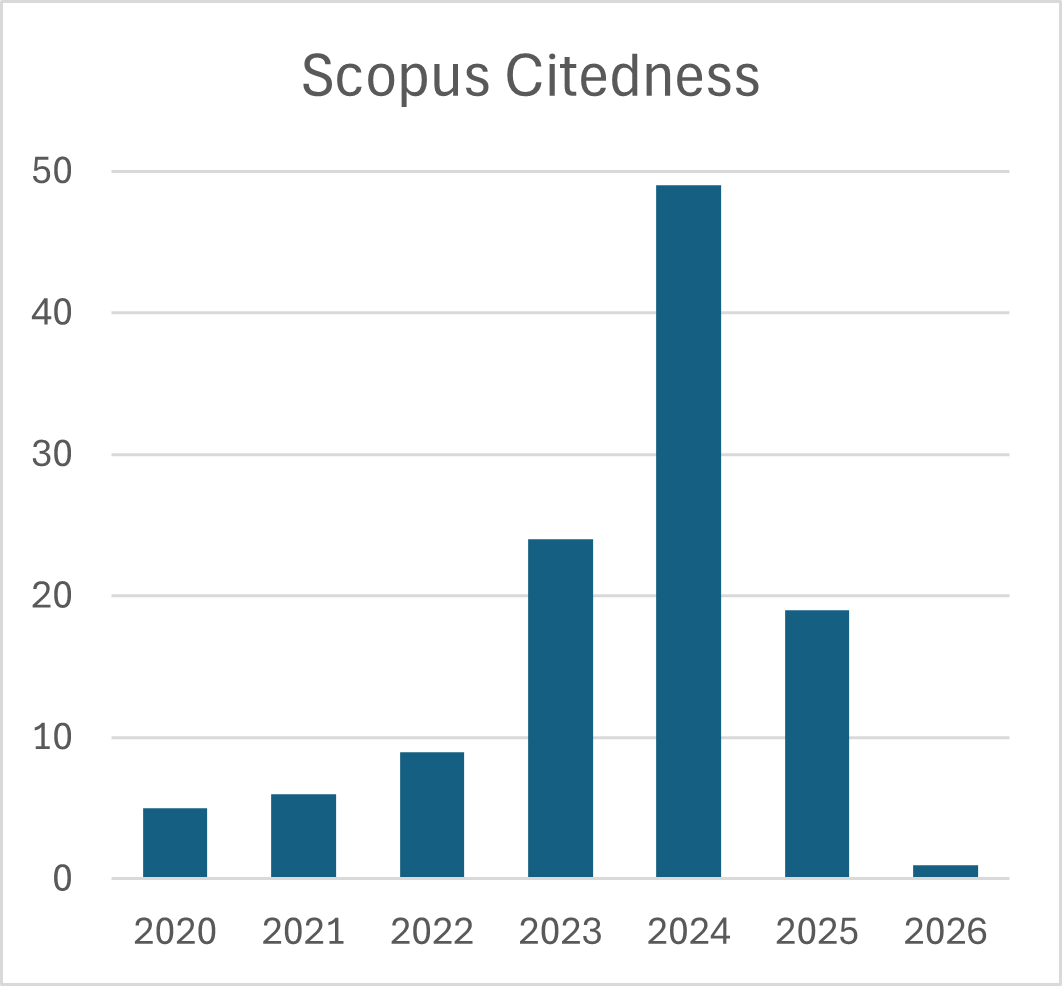Supply Chain Performance Measurement at PT. Perkebunan Nusantara XIV Camming Sugar Factory in Bone District
DOI:
https://doi.org/10.24002/ijieem.v5i2.6861Keywords:
performance measurement , supply chain, key performance indicator (KPI), lean supply chain management (LSCM), analytical hierarchy process (AHP)Abstract
PTPN XIV (PERSERO) of Camming Sugar Factory in Bone Regency Measuring work results in the company is one
of the company's performance evaluation tasks, namely to find out if the results achieved are good enough or still need
improvement. The characteristic of a weak result is the fact that the company's goal is not achieved in the desired way.
The objective of this study is to identify the KPIs and measure the performance indicators at the Bone Regency of PTPN
Camming Sugar Factory. Key Performance Indicator (KPI), Lean Supply Chain Management (LSCM), and Analytic
Hierarchy Process (AHP) methods are used in this study. The results of this study provide 11 Lean metrics that align
with business conditions. Once the indicators are obtained, the KPI weighting is carried out using the Analytical
Hierarchy Process (AHP), prioritizing the performance criteria of the production and supply departments. KPIs that
have a significant impact on a company's supply chain performance. This is reflected in the highest order of weight in
three KPIs, namely production department performance criteria, employee productivity attributes (0.573) and delivery
department criteria, on-time loading (0. 85), and delivery (0.372) attributes. with a weight percentage of 19.1, 16.20%
and 12. 2%. The KPIs in the lowest weight category are collection (0.120) and delivery (0.116) with a weight percentage
of .01% and 3.87%.
References
Akbar, M. R, & Suliantoro, H. (2014). Analisis Pengukuran Kinerja Produksi Menggunakan Metode Sink’s Seven Performance Criteria Pada Depertemen Produksi Mesin PS60 PT.General Electric Indonesia. Industrial Engineering Online Journal, 6(9), 1-10.
Darmawan, A. (2014). Pemilihan Sistem Learning Management System (LMS) Metode AHP Menggunakan Criterium Decision Plus 3.0. Faktor Exacta, 7(3), 260-270.
Dewi, I. (2013). Pengaruh Penerapan TQM, Sistem Pengukuran Kinerja dan Sistem Penghargaan (Reward) terhadap Kinerja Manajerial (studi Empiris pada Hotel di Kota Padang dan Bukittinggi). Universitas Negeri Padang. Jurnal Akuntansi, 1(1), 1-17.
Haris, R. F., & Sovia, A. (2018). Pendekatan Difotai (Studi Kasus: PT WIRA LOGITAMA SAKSAMA). Jurnal Logistik Bisnis, 10(2), 37-49.
Jalal, Q.A., & Safitri, W. (2018). Analisis Kinerja Gudang Dengan Pendekatan Key Performance Indicator (KPI) Dan Analitycal Hierarchy Process (AHP). Jurnal Ilmiah Teknik Industri, 6(2), 71–78.
Kalakota, R., & Robinson, M. (2001). E-Business 2.0. Roadmap for Success. USA: Addison-Wesley.
Khair, F., Dendhy, D., & Wijaya, I. (2019). Perancangan Pengukuran Kinerja Sistem Rantai Pasok Perusahaan Injeksi Plastik Menggunakan Lean & Green Supply Chain Management (LGSCM). Jurnal Penelitian dan Aplikasi Sistem & Teknik Industri, 8(1), 48–60.
Leppe, E. P., & Karuntu, M. (2019). Analisis Manajemen Rantai Pasokan Industri Rumahan Tahu Di Kelurahan Bahu Manado Analysis Of Home-Based Industrial Tofu Supply Chain Management In Bahu Manado. Jurnal Emba, 7(1), 201–210.
Maddeppungeng, A. (2017). Pengaruh Manajemen Rantai Pasok (MRP) pada Daya Saing Dan Kinerja Perusahaan Jasa Konstruksi di DKI-Jakarta. Jurnal Konstruksia, 8(2), 23-36.
Mardiasmo. (2004). Akuntansi Sektor Publik. Yogyakarta: ANDI.
Nordiawan, D., & Hertianti, A. 2010. Akuntansi Sektor Publik (ed. 2). Jakarta: Salemba Empat.
Nurdin, R. H. (2019). Pengukuran Kinerja Perusahaan Pada Pt. Yyy Dengan Menggunakan Metode Balanced Scorecard. Jurnal Manajemen Bisnis dan Kewirausahaan, 3(3), 32-38.
Parhusip, J. (2019). Penerapan Metode Analytical Hierarchy Process (AHP) Pada Desain Sistem Pendukung Keputusan Pemilihan Calon Penerima Bantuan Pangan Non Tunai (BPNT) Di Kota Palangka Raya. Jurnal Teknologi Informasi, 13(2), 18-29.
Priatna, H. (2016). Pengukuran Kinerja Perusahaan Dengan Rasio Profitabilitas. Jurnal Ilmiah Akuntansi, 7(2), 44-53.
Rahmayanti, D., & Putri, U. (2011). Perancangan Model Pengukuran Kinerja Lean dan Green Rantai Pasok Semen Secara Terintegritas. Jurnal Optsimasi Sistem Industri, 10(2), 135-144.
Suryadi, A. & Nurdiana, D. (2015). Sistem Pengambilan Keputusan Untuk Pemilihan Teknisi Lab Dengan Multi Kriteria Menggunakan Metode AHP (Anlytic Hierarchy Process). Jurnal Pendidikan Matematika, 5(1), 11-21.
Vistasusiyanti, Kindangen, P., & Palandeng, I. D. (2017). Analisis Manajemen Rantai Pasokan Spring Bed Pada PT. Massindo Sinar Pratama Kota Manado. Jurnal EMBA, 5(2), 901-908.
Warganegara, T.L.P., Wahyuningsih, F., & Narundana, V. T. (2021). Jurnal Ilmiah Magister Manajemen Analisis Kinerja Karyawan Berdasarkan Key Performance Indikator dengan Menggunakan Metode Human Resources Scorecard (HRSC) Pada PT PLN (Persero) UP3 Tanjung Karang. Maneggio, 4(1), 73-81.
Downloads
Published
How to Cite
Issue
Section
License
Copyright (c) 2024 Anis Saleh, Arfandi Ahmad, Yan Herdianzah, Dirgahayu Lantara, Nur Ihwan Saputra, Muhammad Dahlan

This work is licensed under a Creative Commons Attribution 4.0 International License.








